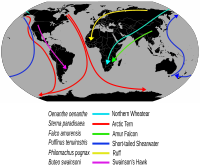
Photo from wikipedia
ABSTRACT Determining the exposure and magnitude at which various pollutants are differentially assimilated at the breeding and non‐breeding grounds of migratory wildlife is challenging. Here, the possibility of applying the… Click to show full abstract
ABSTRACT Determining the exposure and magnitude at which various pollutants are differentially assimilated at the breeding and non‐breeding grounds of migratory wildlife is challenging. Here, the possibility of applying the migratory connectivity framework to understanding contamination in birds is illustrated by considering flame retardants in inviable eggs of a migratory raptor, the black kite (Milvus migrans). The occurrence and concentration of legacy and emerging compounds in eggs from the southeastern peri‐urban area of Madrid city, central Spain, were compared with those from Doñana National Park in southern Spain. A much higher occurrence and concentration of multiple polybrominated diphenyl ethers and Dechlorane 602 were found in Madrid than Doñana, but the opposite patterns were found for Dechlorane Plus. Individuals from these and other breeding areas in western Europe showed a strong intermixing pattern over widespread wintering areas in Africa, as assessed by ringing recoveries and movements tracked by satellite devices. This diffuse migratory connectivity reveals breeding areas as the main contamination grounds. High contamination burdens sequestered in eggs point to rapid assimilation of these compounds before laying, associated with important emission sources in Madrid, especially landfills of partially incinerated urban refuse, and other anthropogenic operations. Diet composition regarding aquatic vs. terrestrial prey, and bioaccumulation and biomagnification processes are suggested to explain differential assimilation of some compounds, especially Dechlorane Plus in Doñana, although a local emission source polluting this area cannot be ruled out. Insight from the migratory connectivity framework can help to disentangle large‐scale patterns of contaminant uptake and refocus attention on key regions and potential causes of chemical hazards in declining migratory species and human populations. HighlightsThis multidisciplinary study integrates population connectivity into pollution assessment.Flame retardants in inviable eggs of black kites were assessed in two populations.A much higher occurrence and concentration of flame retardants were found in Madrid than Doñana.Kites from Western Europe showed a strong winter intermixing in Africa.Diffuse migratory connectivity reveals breeding areas as the main contamination grounds.
Journal Title: Environmental Research
Year Published: 2018
Link to full text (if available)
Share on Social Media: Sign Up to like & get
recommendations!